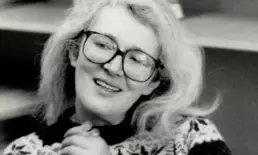These life stories may contain descriptions of childhood trauma and abuse, as well as images, voices and names of people now deceased. If you need help, you can find contact details for some relevant support services on our support page.
English writer, Angela Carter (1940-1992), was in kinship care as a small child.
Angela Carter was born Angela Olive Stalker in suburban London to Olive and Hugh. Hugh was a journalist—“the night editor of London’s Press Association” (Acocella)—and Olive, a lifelong Labor supporter and homemaker.
Her parents’ concern about Angela’s safety meant the child was sent to stay in Yorkshire with her story-telling grandmother during the war.
Back with her parents, the girl was “intensely loved and thoroughly spoiled” by her parents.
She was crammed with treats, bombarded with kittens and storybooks. Her mother never put her to bed until after midnight, when Hugh got back from work—she wanted her company—and, even then, often let her stay up. Hugh brought home long rolls of white paper from the office for her, and as her parents chatted she wrote stories in crayon (Acocella).
Olive’s doting included feeding Angela up.
Carter’s rebellion took the form of anorexia, and it left her with a complicated relationship to food (Hill).
Carter benefited from the 1944 Butler Act which provided for children from non-elite backgrounds to attend elite private schools. She was a good student, but early rejected going to university because it would not provide the necessary escape from her parents—which marriage to Paul Carter in 1960 did.
Instead, with help from her father’s social connections, she began her working life as a journalist, not going to university until she was twenty-two.
While at university, Carter began writing fiction. In 1968—two years after she graduated with a degree in English from the University of Bristol—she won the Somerset Maugham Award and travelled to Japan. The trip was a turning point: she was radicalised as a feminist, ended her marriage with Paul Carter, and became “something of a cult writer”.
In 1975, Carter began writing for the British sociological magazine, New Society. The year before she had published Fireworks, her first collection of short stories and the book for which she is perhaps best known, the award-winning The Bloody Chamber, in 1979. The Bloody Chamber renders fairy tales through a feminist lens, focusing on the experience of the heroine.
Carter was one of the first authors Virago recruited to its editorial board, and her magnificent long essay The Sadeian Woman (1979) was one of the first titles Virago commissioned. Some feminists, Gordon writes, found the book extremely offensive, including Andrea Dworkin…The opening proposition still fills me with huge excitement: ‘We do not go to bed in simple pairs: even if we choose not to refer to them, we still drag there with us the cultural impedimenta of our social class, our parents’ lives, our bank balances, our sexual and emotional expectations, our unique biographies – all the bits and pieces of our unique existences’ (Hill).
References:
Acocella, Joan. “Angela Carter’s Feminist Mythology.” The New Yorker, March 13 2017. https://www.newyorker.com/magazine/2017/03/13/angela-carters-feminist-mythology
“Biography of Angela Carter.” GradeSaver. https://www.gradesaver.com/author/angela-carter
Hill, Rosemary. “The Invention of Angela Carter: A Biography by Edmund Gordon – review.” The Guardian, 22 October 2016. https://www.theguardian.com/books/2016/oct/22/the-invention-of-angela-carter-a-biography-by-edmund-gordon-review
Image available here.
